The Photographers
I would like to express my gratitude to the photographers and members of regional mushrooms clubs who permitted me to use their photographs for this project. Represented among your images are both wild mushrooms that are commonly seen, and those rarer specimens that are seldom found, much less photographed. Your photographs were a major inspiration for this website and I thank you for your generosity.
Some of the photographs found here might also be found in books, articles, and other websites, but many others were previously unpublished and would have remained so had they not been recovered from digital archives, or rescued and converted to digital format from old slides hidden away in an attic or boxed in a lab. It would have been a great loss had these images remained unavailable. I am thankful that I can present them here so that mushroom enthusiasts worldwide may enjoy their beauty.
In the following sections I want to acknowledge individual photographers, each of whom provided numerous images that appear on this site. I have also listed below the names of several people who provided one or more photographs that were significant contributions. Again, each of you have my sincere thanks. This project would not have been possible without you.
Catherine Ardrey
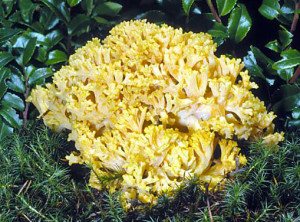
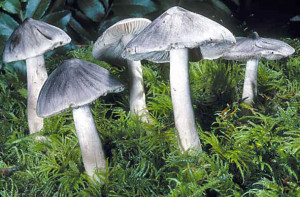
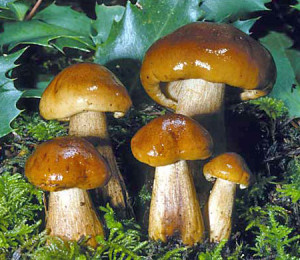
Catherine was an active member of a photo exchange, along with Kit Scates, Dr. Michael Beug, and Gene Butler, where over a dozen nationwide amateur mycologists cooperated in and exchanged photos over many years. If they didn’t know the name of a mushroom someone else in the exchange could offer the correct name. They specialized in the mushrooms of the areas where they lived, which was from all over the United States. It may have begun with membership in the North American Mycological Association (NAMA).
Note: Catherine’s photographs were gifted to the Oregon Mycological Society (OMS) many years ago after her death and cared for by Maggie Rogers, who was then the librarian. When I told Maggie about my mushroom project she gave me permission to use them. I don’t have any pictures of Catherine and have tried to find anyone who knew her when she was active in NAMA or other mushroom clubs. So far I have not been able to locate anyone with information about her, except what you read here. Her contribution to wild mushroom photography is exceptional. I believe she lived in the Coos County area of Oregon where she took most of her photographs. Here are three of them.
Harley Barnhart
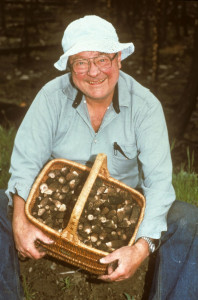 Retired from a career in the Air Force (1943-1974), Harley was an amateur photo enthusiast since 1937. He discovered mushrooms in 1963 when a newly plowed and sodded field at Maxwell AFB in Alabama erupted in a massive fruiting of Chlorophyllum molybdites. Tours of duty before 1963, in Italy, Korea, and Japan, unfortunately did not included anything mycologically. A year in Viet Nam also did not encourage mushrooming, but assignments in Virginia, California, Panama, South Dakota, and again in Alabama, were fruitful. So was retirement to Florida where there was easy access to the wondrous Southern Appalachians.
Retired from a career in the Air Force (1943-1974), Harley was an amateur photo enthusiast since 1937. He discovered mushrooms in 1963 when a newly plowed and sodded field at Maxwell AFB in Alabama erupted in a massive fruiting of Chlorophyllum molybdites. Tours of duty before 1963, in Italy, Korea, and Japan, unfortunately did not included anything mycologically. A year in Viet Nam also did not encourage mushrooming, but assignments in Virginia, California, Panama, South Dakota, and again in Alabama, were fruitful. So was retirement to Florida where there was easy access to the wondrous Southern Appalachians.
The North American Mycological Society (NAMA) forays after retirement opened more opportunities. Their photo contests provided exposure that led to publications in field guides and journals.
In 1985 Harley married Kit Scates, a renowned amateur mycologist and photographer. With Kit, he hunted and photographed extensively in Idaho, the Pacific Coast, and the Northern Cascades. They also toured Europe and Thailand.
When Harley could not walk the woods and climb hillsides any longer, he became occupied in relabeling and verifying identification of mushroom photographs on slides with a view toward converting more of them to digital format. He also worked on the classification, filing, and labeling of Kit’s extensive slide collection, much of which was dedicated to teaching and lecture activities.
Michael Beug, PhD
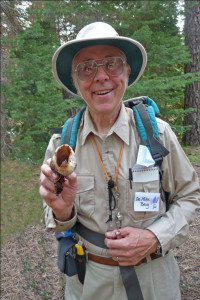 Michael Beug started mushrooming in 1969 in graduate school after taking an adult education class from Dr. Daniel Stuntz at the University of Washington. He completed his PhD in Chemistry at the University of Washington in 1971. Michael spent most of his career at Evergreen State College in Olympia, Washington, where he taught chemistry, mycology, and organic farming. He also served 7 years as Senior Academic Dean and for many years as head of the Environmental Studies Division.
Michael Beug started mushrooming in 1969 in graduate school after taking an adult education class from Dr. Daniel Stuntz at the University of Washington. He completed his PhD in Chemistry at the University of Washington in 1971. Michael spent most of his career at Evergreen State College in Olympia, Washington, where he taught chemistry, mycology, and organic farming. He also served 7 years as Senior Academic Dean and for many years as head of the Environmental Studies Division.
Soon after arriving at Evergreen State College he met Kit Scates and Dr. Alexander Smith, and began photographing fungi. His photographs have appeared in more than 30 books and articles on mushrooms. In 1975 he joined the North American Mycological Association (NAMA) and the Pacific Northwest Key Council, a group dedicated to writing macroscopic keys for the identification of fungi. He has served four terms as president of the Pacific Northwest Key Council as well as on the NAMA Education Committee, the Toxicology Committee, and was the winner of the 2006 NAMA Award for Contributions to Amateur Mycology.
He regularly writes about mushroom toxicology in McIlvainea where for many years he was the editor, and The Mycophile, as well as Mushroom: The Journal of Wild Mushrooming and has prepared many PowerPoint presentations about mushrooms for the NAMA Education Committee. You can often find him lecturing to mushroom clubs throughout the Pacific Northwest and occasionally farther afield on speaking engagements. He loves to teach workshops for beginners and several times has taught classes at national NAMA forays. For 32 years he taught Evergreen State College students mushroom identification whenever his schedule would permit it. In retirement, he still looks forward to returning as a guest speaker on mushrooms or going with students on extended field trips. He has remained active as an identifier and speaker at local mushroom club forays including the Spokane Mushroom Club and the Oregon Mycological Society. His collection of mushroom pictures included in this project span over 30 years.
Dr. Beug’s latest contribution is the new book, Ascomycete Fungi of North America, A Mushroom Reference Guide of which he is a co-author along with Alan and Arleen Bessette. This is a beautiful book with more than 400 pages of pictures and information about non-gilled wild mushrooms.
Elmer Galbi
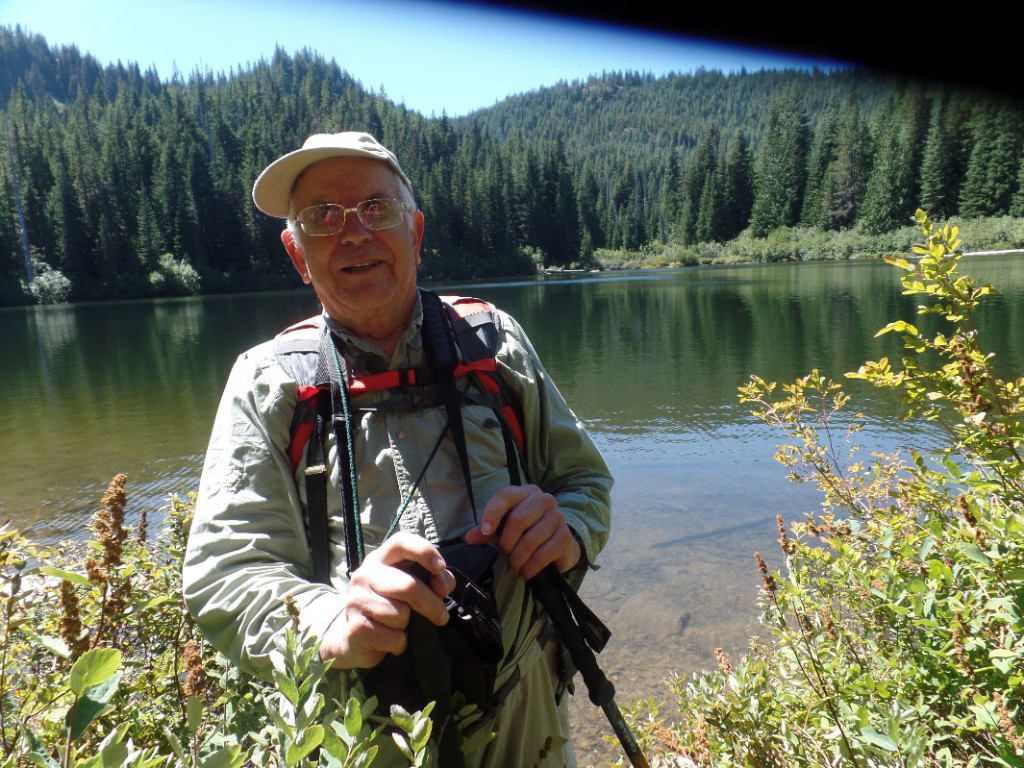 About five years ago when I retired, my wife and I started hiking on Mt. Hood. That’s when I developed an interest in the wild flowers and mushrooms that I saw. I wanted to learn about them, which I have.
About five years ago when I retired, my wife and I started hiking on Mt. Hood. That’s when I developed an interest in the wild flowers and mushrooms that I saw. I wanted to learn about them, which I have.
When I encounter a wild flower or mushroom that I recognize, it’s like encountering an old friend. If I see ones that I do not know, it’s like passing a stranger on the street. It’s more fun hiking among friends. I am now 81 years old and feel like I have to rush, in that I do not have too many more years to make friends with the flowers and mushrooms.
Anna Moore
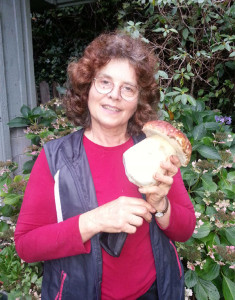 Anna is an amateur mycologist and photographer with a science background and a love of the natural world. She retired from UC Berkeley in 2005 where she worked in Environmental Compliance and now spends much of her time on the Oregon coast hiking and foraging.
Anna is an amateur mycologist and photographer with a science background and a love of the natural world. She retired from UC Berkeley in 2005 where she worked in Environmental Compliance and now spends much of her time on the Oregon coast hiking and foraging.
She has been interested in wild mushrooms for over 30 years, starting as a member of the Mycological Society of San Francisco (MSSF) in 1985. Anna is often available to give talks to mushroom beginners at local schools, parks, and organizations. She also enjoys developing recipes using a variety of her own mushroom powders.
Anna is a member of several mushroom clubs including Cascade Mycological Society (CMS) in Eugene, OR; Lincoln County Mycological Society (LCMS) in Lincoln City, OR; and Sonoma County Mycological Association (SOMA) in Northern California.
Bruce Newhouse
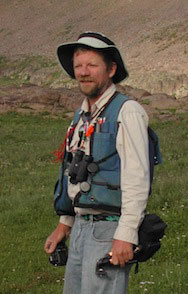 Bruce is part of Salix Associates with 27 years of experience in field ecology and natural resource planning in Oregon, including 10 years in city and county planning offices, and 17 years in private consulting. He is active in both professional and volunteer activities in natural resources and related disciplines.
Bruce is part of Salix Associates with 27 years of experience in field ecology and natural resource planning in Oregon, including 10 years in city and county planning offices, and 17 years in private consulting. He is active in both professional and volunteer activities in natural resources and related disciplines.
His education and experience is focused on botany, ecology, and ecological relationships between plants, wildlife, fungi, and other organisms. He has been part of numerous botanical and multi-disciplinary inventories and assessments at Salix Associates. They have developed restoration and management plans for several large sites in the southern Willamette Valley as well as other sites.
Bruce is an experienced instructor in botany, butterfly ID, ecology, and fungal identification. He has presented at universities, community colleges, professional organizations and non-profits. His photographs have been published in state and national publications. For the past several years he and his wife, Peg, have been the mushroom coordinators for the Mt. Pisgah Arboretum Mushroom Festival, in Eugene, OR. It is one of the largest fund-raisers for the Arboretum and occurs the last Sunday in October.
Ben Pruitt
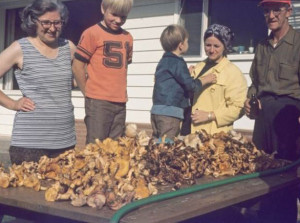 In honor of Ben H. Pruitt (1888-1993) a mushroom that he discovered is now called Amanita pruittii. Ben was a farmer, shopkeeper, and avid naturalist, a founder of historical and nature societies, an environmentalist, and amateur mycologist who, at the age of 88, was actively collecting, photographing and writing field descriptions of fungi.
In honor of Ben H. Pruitt (1888-1993) a mushroom that he discovered is now called Amanita pruittii. Ben was a farmer, shopkeeper, and avid naturalist, a founder of historical and nature societies, an environmentalist, and amateur mycologist who, at the age of 88, was actively collecting, photographing and writing field descriptions of fungi.
The Pacific NW Key Council came across some correspondence from 1976-1977 between Dr. Alexander H. Smith and Ben Pruitt, who was living in Springfield, Oregon, where it addressed the identity of a mushroom that had appeared in large numbers in a 40 acre field of Sorghum that was repeatedly reseeded over several years.
According to this letter, Dr. Smith wrote that this curious entity was in fact an unknown species of Amanita and proposed to name it after its collector. Amanita pruittii has also been located at other sites in California and Oregon, one being a grassland habitat near Fisher Butte, at Fern Ridge Reservoir, west of Eugene, OR.
A newspaper article published in 1948 had an article about Ben Pruitt giving a talk to a local Garden Club about wild mushrooms. It’s amazing what you can still find on the internet.
Freeman Rowe
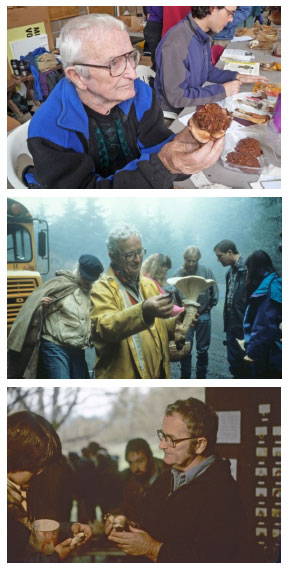
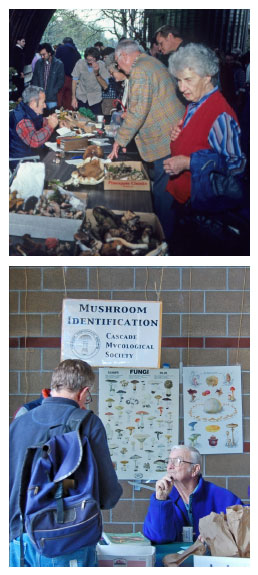 The Father of the Cascade Mycological Society (CMS), Freeman inspired and trained budding mycophiles for decades in Lane County, Oregon.
The Father of the Cascade Mycological Society (CMS), Freeman inspired and trained budding mycophiles for decades in Lane County, Oregon.
His mycological legacy began in 1968 as a biology instructor (botany and marine biology) at Lane Community Collage (LCC). He then began teaching classes about mushrooms. This later became a lecture and field course taught every fall from 1981 until 1998.
Many of his former students still live in this area creating a thriving mushroom community. In 1998 some of his former students got together and formed the Cascade Mycological Society. One of the most notable events is the nationally recognized Mushroom Festival at Mt. Pisgah Arboretum at the end of every October.
Freeman still helps with the collection and identification for the mushroom displays and decides who brought in the “Best in Show” mushroom. He said, “it has become such a big event that it feels like my kid has grown up.” Now in his 80s, Freeman is still part of the mushroom community.
David Rust
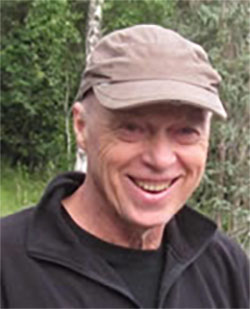 David is co-founder of the Bay Area Mycological Society. He created the science-oriented All California Club Forays in 2005 and the Mycoblitz science forays at Point Reyes National Seashore from 2005-2007. He is an active participant in the Yosemite Fungal Survey. David is past president, vice president and fair committee chair of the Mycological Society of San Francisco.
David is co-founder of the Bay Area Mycological Society. He created the science-oriented All California Club Forays in 2005 and the Mycoblitz science forays at Point Reyes National Seashore from 2005-2007. He is an active participant in the Yosemite Fungal Survey. David is past president, vice president and fair committee chair of the Mycological Society of San Francisco.
For over a decade, David has followed the news and research about the devastating forest pathogen, Phytophthora ramorum, that causes the disease known as “Sudden Oak Death,” and is a member of the California Oak Mortality Task Force.
David is a participant in the North American Mycoflora Project, which is a citizen science endeavor to document all fungi on the continent. He is a regular speaker at the Santa Cruz and Point Reyes National Seashore fungus fairs. David just completed three years as President of NAMA (North American Mycological Association) and has been elected to another three year term.
Catherine “Kit” Scates
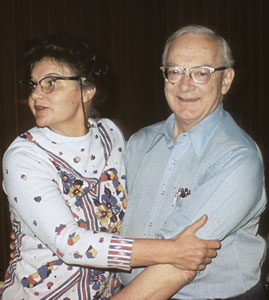 The Pacific NW Key Council is dedicated to the creation and publication of field keys of the Pacific Northwest. It was initiated in 1974 by Kit Scates of Post Falls, Idaho. Kit was an amateur mycologist of the highest rank. She became the events organizer, principal recruiter and first President. She developed the North American Mycological Association (NAMA) with the supervision of Dr. Joseph Ammirati and the late Dr. Daniel Stuntz (pictured here), both at the University of Washington.
The Pacific NW Key Council is dedicated to the creation and publication of field keys of the Pacific Northwest. It was initiated in 1974 by Kit Scates of Post Falls, Idaho. Kit was an amateur mycologist of the highest rank. She became the events organizer, principal recruiter and first President. She developed the North American Mycological Association (NAMA) with the supervision of Dr. Joseph Ammirati and the late Dr. Daniel Stuntz (pictured here), both at the University of Washington.
She and Dr. Stuntz wanted to bring information that would allow amateurs to successfully identify mushrooms found in the Pacific NW. At this time there were few field guides and they only covered a small number of species found in the region. There were no keys readily accessible to amateurs. Kit then wrote a picture key to common genera of gilled mushrooms and a picture key to mushroom terms that are still great tools for beginners.
Kit founded the North Idaho Mycological Association and was also a NAMA Vice President, Regional Trustee, and chair of the NAMA Education Committee. She also served as the first Key Council President. Kit made a poster about mushroom poisonings and their medical treatment. Kit was very involved in many mushroom projects. She married Harley Barnhart in the late seventies and they made Idaho their home. Harley was another expert photographer of mushrooms and his mushroom pictures are also presented in this project.
Kit won the North American Mycological Association (NAMA) award for Contributions to Amateur Mycology in 1976. She was also given the “President’s Outstanding Service Award” posthumously for her many years of dedicated service to NAMA in a variety of roles including photography workshops and mushroom educational workshops. Because of Kit’s many contributions, our knowledge today of wild mushrooms has benefitted greatly.
Matt Trappe, PhD
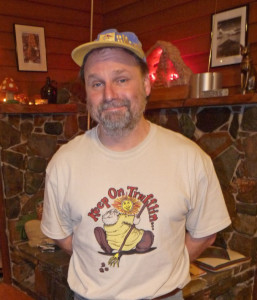 Matt is a research ecologist with many years experience working in western forests. His specialties are disturbance ecology, particularly fire, mycology, and soil microbiology, DNA, and isotopic analysis, forestry, and botany.
Matt is a research ecologist with many years experience working in western forests. His specialties are disturbance ecology, particularly fire, mycology, and soil microbiology, DNA, and isotopic analysis, forestry, and botany.
He holds a PhD in Environmental Sciences and a MS in Forest Science/Forest Resources, both from Oregon State University. He also has a BS in Electronic Engineering/Automated Manufacturing and worked as an electromechanical engineer for a decade before entering graduate school.
Matt received his MS studying the ecology of the winter chanterelle, Craterellus tubaeformis. He has served as Trufflemaster for the North American Truffling Society (NATS) since 1998, leading forays and administers the NATS web page. Matt is one of the authors of the Field Guide To North American Truffles.
Glenn Walthall
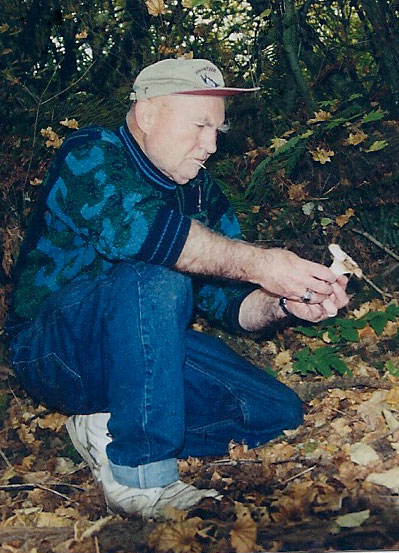 For many years Glenn was a life member of the Oregon Mycological Society (OMS) in Portland, OR. For about 30 years he enjoyed teaching people about mushrooming. Glenn had a master’s degree in botany, lead field trips and seminars on fungi at different community colleges and parks in the Portland area.
For many years Glenn was a life member of the Oregon Mycological Society (OMS) in Portland, OR. For about 30 years he enjoyed teaching people about mushrooming. Glenn had a master’s degree in botany, lead field trips and seminars on fungi at different community colleges and parks in the Portland area.
He said “shrooming is a good hobby for just knowing what you see.” Certified by poison control in Multnomah, Clackamas, and Washington County hospitals, he was on call during mushroom season.
His mushroom photographs were donated to the Oregon Mycological Society (OMS) in 2002. Thanks to Maggie Rogers, the librarian for OMS for many years, for giving me permission to use Glenn’s photographs for this project.
Additional Contributors
I would also like to thank the following people for their photographic contributions.
Bob Blanchard
Mich Conklin
Terry Gillespie
Kris Jacobson
Chris Melotti
Stewart Meyers
Ron Patton
Steve Trudell
The Cascade Mycological Society (CMS)
And a special thank you goes to Maggie Rogers from Oregon Mycological Society (OMS) for believing in my vision and supplying so many wonderful mushroom photographs from the OMS archives that would have otherwise never been seen. Maggie also introduced me to Michael Beug who was so generous, not only in the use of his photographs, but allowing me to use Kit Scates and Harley Barnhart’s photographs that they had taken over many years, which contributed greatly to this project.